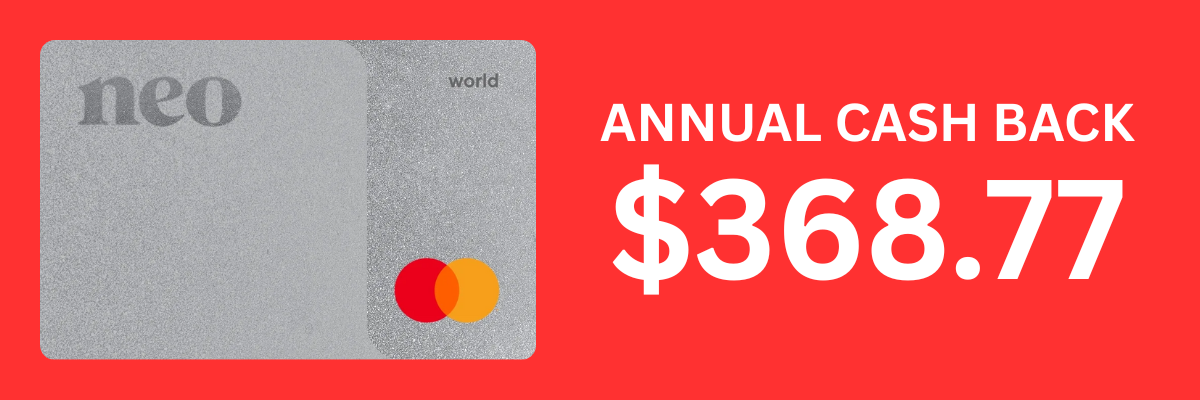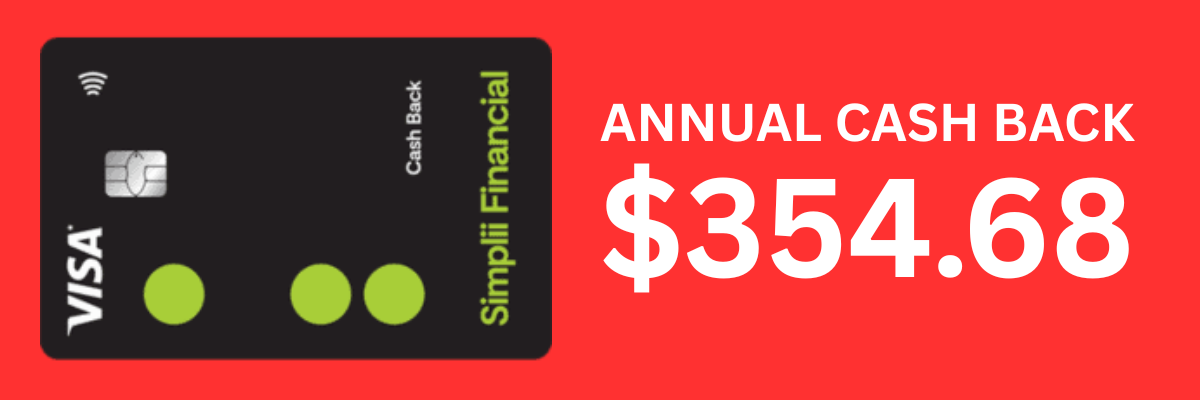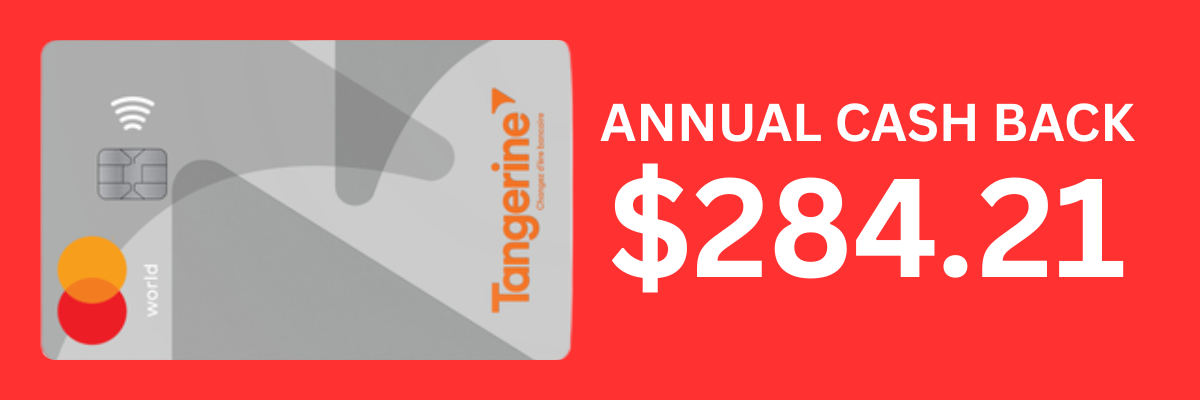Having a credit card allows you to make purchases, earn rewards, and build credit history. But if you earn less than $60,000 a year, choosing a no-fee credit card may be a better choice. That's because with a premium credit card, you may not spend enough to earn cash back or points, which would be outweighed by the annual fees.
For example, if you use a premium card that offers $400 in rewards but charges an annual fee of $150, then your actual gain is only $250. So, if you’re earning less than $60,000, it may not be worth it to pay an annual fee for a credit card.
So, I decided to compare five no-annual-fee credit cards. With that, I put my money nerd skills to the test and created a spreadsheet with a fictitious budget for an Ontarian who earns $60,000 in gross income.
The results? When I plugged this into our spreadsheet, here’s what an individual would earn in a year without promotions or welcome offers:
- Neo World Mastercard - $368.77
- Simplii Financial Cash Back Visa Card - $354.68
- PC World Mastercard - $309.77
- Tangerine Money-Back World Mastercard - $284.21
- MBNA SmartCash Platinum Plus - $234.89
Follow along to learn how I was able to crunch these numbers.
Sample budget of an Ontarian earning $60K
I devised this fictitious budget based on an individual earning $60,000 a year living in Ontario. They would be taxed at an average tax rate of 21.71%, resulting in a tax of $13,023. Thus, the after-tax income will be $46,977.
For each expense category, I allocated a percentage of their income. The amounts are based on what an average person typically spends each month.
Here are my assumptions with the budget I created:
- For groceries, I gave them just under $400/month and about $150/month on restaurants.
- They have ongoing car payments that's approximately $470/month. They'll also need to fill up on gas, which is around $195/month.
- They make regular bill payments such as for utilities (such as internet, phone bill, electricity etc.) and insurance, which comes to approximately $275/month.
- Entertainment and shopping works out to be nearly $195/month for each category since they need to have some fun and enjoy spending their hard-earned money.
- For travel, they'll go on mini road trips around Ontario, which is about $117/month.
- Subscriptions such as streaming and music services that adds up to about $78/month.
- This person also need to take care of their health and fitness, so I allocated around $78/month that includes a gym membership or buying supplements.
- Since housing is quite expensive in Ontario, I'm assuming this individual has a roommate to split the cost of rent payments.
- They're also working towards future savings goals and diligently set aside 10% of their paycheque, which is around$391/month.
Keep in mind that your numbers may differ from this budget, as each person has their own unique lifestyle and spending habits.
The selection criteria
I selected these credit cards based on individuals who want to earn cash back or points from their everyday spending with no annual fees. Additionally, they must have an income requirement of less than $60,000 and a mid-range credit score requirement, making it easier to meet the eligibility requirements. I also ensured that there were a decent number of perks and benefits associated with the credit card.
Here’s a comparison of Canada’s best free credit cards:
How I calculated the rewards
Here’s an overview of each credit card's benefits and how I created the formulas. You can follow along with my logic by reviewing my spreadsheet.
Here, I calculated how much each credit card would reward this individual in cashback or points, and any welcome offers.
All the credit cards, except for the PC World Mastercard, provide cashback. The cashback amount is a certain percentage based on your spending amount in each category. Groceries and gas usually provide a higher cashback percentage which is usually 2% cashback. Let's say, you spend $100 towards filling up on gas. Therefore, you'd earn $2.00 in cashback.
As for the PC World Mastercard, the cardholder receives PC Optimum points based on how much they spend in different categories. To compare apples to apples, I was able to determine that the company gives a certain percentage back in points.
For example, if you spend $100 at No Frills, you'll receive 2% back in points. That means you would receive 2,000 PC Optimum points, which is worth $2.00.
Note: there are two expense categories that won't go towards credit card purchases:
- Housing: Since this person is a renter, I'm going to assume that they e-transfer their landlord rent every month. Thus, they don't make rent payments on their credit card. As a landlord myself, this is a common practice.
- Savings: I'm going to assume that this money will be directed towards a High-Interest Savings Account (HISA) instead.
If you're curious to see how much cashback you could earn, we developed a handy credit card cash back calculator. So all you have to do is plug in your numbers, and you’ll instantly see how much your potential cash back will be.
Neo World Mastercard

The Neo World Mastercard offers a straightforward incentive: 2% cashback on bills, gas, and groceries. You receive 0.5% cashback on everything else. When you shop at over 10,000 partners across Canada, you earn instant cashback. Some of the Neo partners include Simons, The Keg, Aldo, Petvalu and many more. In my spreadsheet, I applied those percentages accordingly.
As a result, the total cashback amount came to $368.77. This card may be a solid choice for individuals who spend a significant amount on shopping at the grocery store, filling up at the pump, and setting up recurring payments. Also, the instant cashback can be very gratifying, as some other credit cards only pay out the cashback at the end of the year.
Also, there's a current promotion where you can receive a $60 welcome bonus. So, in the first year, this individual could earn up to $428.77.
Simplii Financial Cash Back Visa Card

With the Simplii Financial Cash Back Visa Card, you earn sizeable 4% cashback on restaurants, followed by 1.5% on gas, groceries, and pre-authorized payments, and 0.5% on everything else.
Their current promotion is two-fold: if you spend $50 on transit with PRESTO in the first two months, you can earn a $50 PRESTO voucher. This credit card makes it ideal for those travelling with their PRESTO card within the Greater Toronto Area, Hamilton, and Ottawa areas. The second promotional offer is that you can earn 8% cashback on restaurants, bars, and coffee shops up to $1,000 in spending for the first three months (capped at $80 cash back).
In this exercise, even though the individual owns a car, I will assume they will use public transportation to take advantage of the $50 PRESTO voucher. For instance, they could drive to a GO station, park their car, and then take the GO train to get to their office in downtown Toronto. I also applied an 8% cashback offer for the first three months to the restaurants category. Hence, the total cashback came to $423.47, making it the top of the pack.
Note that without the two promotional offers, the cashback amount would be $354.68, which is the typical amount this individual would receive in the following years.
PC World Mastercard

The PC World Mastercard comes with a long list of benefits. You get 2% back in points at their grocery store chains, a minimum of 3 cents per litre at their gas stations, 3.5% back in points at their pharmacy brands, 2% back in points at Joe Fresh, and then 1% back in points on dining, transit, and everything else.
For groceries, I applied the 2% rate. For gas, I had to find out the cost per litre ($1.33), and then determined that the individual fills up about 147 litres per month. Thus, with 3 cents per litre, it amounted to $4.42 in gas rewards. Health and fitness, I allocated 3.5% as I assumed this individual was spending their money at Shoppers. Since this credit card distributes PC Optimum points as the reward, I converted it to a cashback equivalent, which came to $309.77. Furthermore, I did not see any promotional offers at the time of writing this article.
Tangerine Money-Back World Mastercard

At the time of writing this article, the Tangerine Money-Back World Mastercard welcome offer is $120 in money back when you spend $1,500 in the first three months. You can earn 2% by selecting two categories of your choice. To unlock a third category, you must open a Tangerine Savings account. For this exercise, I assume that this individual won’t be opening a savings account, so they’ll have access to choose two categories to earn 2% cash back.
The two categories I chose were groceries and car payments (recurring bill payment). They would earn 0.5% on everything. Typically, the cashback amount is $284.21. But since I added the $120 welcome offer, the total cash back this individual would earn is $404.21.
Remember that welcome offers are only for the set timeframe. So the following year, your cashback rate may not be as high.
MBNA SmartCash Platinum Plus

Currently, the MBNA SmartCash Platinum Plus card offers a welcome bonus of 5% cash back on gas and groceries for the first six months. After six months, it drops down to 2%. You also earn 0.5% on everything else. In my spreadsheet, I factored in the 6-month promotional offer for the groceries and gas expenses. So, the total amount of cashback came to $340.58. Without the promotional offer, the cashback amount would be $234.89
The Verdict
Welcome offers are good incentives, but they don’t last forever. As a result, you should not make your decision based on the welcome offers unless you plan to cancel the credit card once you get the bonus, and get a credit card offering a higher payout.
The difference between the highest and lowest cash back amounts without any promotional offers is $133.88 when comparing these credit cards. No doubt that it’s a decent amount of cash, and could mean treating yourself to a nice meal or some new clothes. Bear in mind that you will also want to consider other factors, such as the interest rate, as well as additional benefits like extended warranties, purchase protection, and retail discounts with partner stores.
Regardless, all of these credit cards are excellent choices for individuals earning less than $60,000 per year. It ultimately comes down to which categories you spend the most money on and being able to earn the highest cashback or rewards based on these categories.
The credit cards that I use
Personally, I use several credit cards, each with a distinct purpose. First, I use my Neo Mastercard. It has no annual fee and offers 1% cashback. I earmark this credit card for business expenses as a freelancer. Through my research, I’m tempted to switch to the Neo World Mastercard, as it offers better perks and doesn’t charge an annual fee either.
Next, I have my Wealthsimple credit card. It offers 2% cash back on all my purchases. I use this for personal expenses. It does have a monthly charge of $20, which works out to $240 per year. Fortunately, my fee is waived because I meet their requirements. I receive the cashback amount in my chequing account on a monthly basis.
Lastly, my husband and I have the PC Insiders World Elite Mastercard. It comes with an annual fee of $120, which is waived in the first year. We use this credit card for joint household expenses. Since we’re loyal to shopping at their grocery store chain, such as Loblaws and No Frills, as well as filling up at Esso, we’re able to rack up points and redeem them regularly. For us, it’s worth it to pay the annual fee because the amount of points we earn easily outweighs the cost. We also use PC Express to have our groceries delivered to our home, making it super convenient.
Choosing a credit card that suits your needs
There you have it! I’ve walked you through how to calculate the potential rewards or cashback you could receive based on a realistic $60k income and daily expenses. Remember, the best credit card is the one that fits your spending habits and won't cost you more than it earns in cashback or points.
Now, you can apply the same approach with your own budget. All you have to do is plug in your real numbers and compare what your desired credit cards would give you in rewards in a year. You may be amazed to discover that a no-fee credit card may give superior value as a premium credit card once the annual fees are factored in.
Ultimately, the best card for you is the one that fits your lifestyle and gives you the most rewards or cash back.



